Wildlife
Wildlife
At the Wildlife Clinic, our goal is to provide professional care to sick, injured, and orphaned native wildlife so healthy animals can be returned to their natural habitat. In some cases, wildlife may not need treatment at all. This page shares some general guidance on when wildlife may need assistance.
Do not try to pick up or move an injured animal until you have spoken with a professional who can guide you on the safest method of action.
Call our 24-hour wildlife hotline at 215-482-7300, option 2 to for our team to assist or text us at (215) 853-6271.
Visit our Frequently Asked Questions page for information about the Schuylkill Center Wildlife Clinic, the types of animals we take, and other wildlife rehabilitation centers in our region.
Adult Bird
A bird should be taken to a wildlife rehabilitator if…
-
- It is infested with flies, fly eggs or maggots (usually looks like rice or grain in the bird’s feathers or skin)
-
- Its head is tilted
-
- It has a drooping or twisted wing
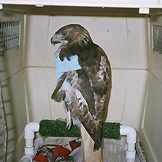
- It has a drooping or twisted wing
-
- It is caught or entangled in debris, e.g. string, net, jar, etc.
-
- It is stuck in a glue trap, or stuck or covered in oil, tar, etc.
-
- Its eyes are crusty and/or appear unable to see
-
To safely contain and transport a bird to a wildlife rehabilitator for care, follow these steps:
- Prepare a box or other container that can be securely closed. Line the bottom of the box with a paper towel, t-shirt, or similar so that the bird can stand without sliding around in the box.
- Use a towel or blanket to gently throw or drop over the bird, completely covering its head and wings. Covering the bird’s eyes will help to reduce stress and keep them calmer during handling. Wearing protective gloves, use the towel to scoop the bird up while supporting their body, and place them gently in the prepared transport container. Partially close the container, then gently pull the capture towel out of the box- do not leave the bird wrapped in a towel for transport.
- Ensure the transport container is securely closed to prevent escape. For a cardboard box, fold the flaps closed and use tape to secure.
- Keep the animal in a warm, dark, quiet place that is away from people and pets (a dark closet or bathroom works well). Resist the temptation to open the box to check on the animal or to take photos, as this will cause increased stress. Avoid loud noises, talking, and music.
- Do not offer food or water, unless instructed to do so by a permitted wildlife rehabilitator. Improper food given at the incorrect time can end up making an injured or orphaned animal very sick and can negatively impact treatment when they arrive at the rehabilitation center.
- Bring the bird to your nearest permitted wildlife rehabilitation center as soon as possible. The sooner the animal receives proper treatment, the higher the chances that they will be able to be successfully rehabilitated and return to the wild.
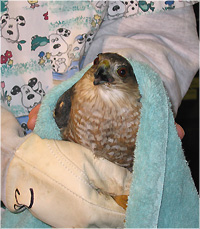
What to do if I have found a bird…
That has flown into a window, glass door, or other structure?
Act quickly to contain the bird; follow the above instructions for safe containment and transport. Place the bird in a warm, dark, and quiet place and contact a wildlife rehabilitator. Do not offer food or water. Avoid opening the box to check on the bird as they may attempt to escape and the additional stress may cause further harm. Do not release the bird, even if it becomes more alert and active or seems to be unhurt, as it may still have injuries that are not readily apparent.
Inside my house?
Lead the bird to a room that has doors or windows to the outside by turning off all lights and blocking off all other areas of the house, except for the path to the desired exit. Open available doors and windows to the outside, keep people and pets away from the area, and give the bird some time to make its own way out. Be sure to cover mirrors and close blinds or hang sheets over unopened windows so the bird does not attempt to fly into them. Never try to chase a bird out of a building as the additional stress will make it more likely that the bird will injure itself in the attempt to escape.
Sitting on the ground unable to fly?
→ Spring / Summer: If the bird seems otherwise normal, hopping around and alert, it is probably a fledgling just leaving the nest. Fledglings are feathered, and may appear to be adults, but usually can be distinguished by their shorter tails. If the bird is in imminent danger (e.g. on the road), carefully move it to the nearest safe location, preferably under the cover of a bush or tall grass and within 15 feet of where it was found. Otherwise, do not handle the bird, as it does not need help. For more information on fledglings, please see: https://www.audubon.org/news/when-you-should-and-should-not-rescue-baby-birds
→ Fall / Winter: If an adult wild bird can be approached or captured, it needs help. Place the bird in a warm, dark, and quiet box and contact a wildlife rehabilitator. Do not offer food or water.
→ If you are unsure if a bird is injured or orphaned, observe from a distance. Take a clear photo and text or email the Wildlife Clinic so our rehabilitator can help determine if the animal is in need of help.
Caught on a glue trap or sticky tape?
Do not attempt to remove the bird from the trap or tape. Improper removal can cause serious injury or death. Apply tissue or sprinkle cornmeal, flour, powder, or another dry substance over the exposed sticky parts of the trap. Place the bird and trap inside of a closed, dark container. Do not offer food or water. Bring the bird to your nearest rehabilitator immediately.
Baby Bird
What do I do if I have found a Baby Bird…
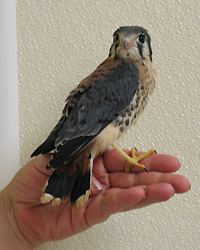
…that has fallen from its nest?
If a baby bird has its eyes closed, has no or few feathers, and is unable to stand or grip with its feet, then it is a hatchling or nestling and still belongs in the nest. If the baby appears uninjured, every attempt should be made to return the bird to its nest. Contrary to popular belief, birds will continue to care for their young even after being handled by humans. If the hatchling/nestling is cold, it should be warmed up with a heating pad or other heat source before being returned to the nest. Watch the nest from a distance, and if the parents do not return within two hours or by dusk, then contact a wildlife rehabilitator.
Fresh feces around the baby and the nest indicate that the baby is being fed by the parents. Baby birds only defecate when they are fed. Even if you do not witness the parent feeding the baby, if you see fresh feces it means the baby is being tended to and can be left alone.
…whose nest has fallen down?
If the nest is still relatively intact, place it into a shallow container like a berry basket or tupperware. The container must have holes in the bottom for drainage. If possible, mount the nest in its original location, using string or wire to attach it securely to a sturdy branch. Otherwise, select a location as close as possible that is protected from direct sunlight, wind, rain, pets, and children. Watch the nest from a distance, and if the parents do not return within two hours or by dusk, then contact a wildlife rehabilitator.
…whose nest has been destroyed?
If the bird seems otherwise normal, hopping around and alert, it is probably a fledgling just leaving the nest. Fledglings are feathered, and may appear to be adults, but usually can be distinguished by their shorter tails and fluffier bodies. If the bird is in imminent danger (e.g. on the road), carefully move it to the nearest safe location within 15ft of its original location, preferably under the cover of a bush or tall grass. Otherwise, do not handle the bird, as it does not need help.
…has feathers but is on the ground and unable to fly?
If the bird seems otherwise normal, hopping around and alert, it is probably a fledgling just leaving the nest. Fledglings are feathered, and may appear to be adults, but usually can be distinguished by their shorter tails. The bird should be placed in a nearby bush (not a tree) away from the street, pets, and children. Watch the bird from a distance to see if the parents return to feed it. If the parents don’t return within 2 hours or the bird appears injured or lethargic, contact a wildlife rehabilitator.
A baby bird should be taken to a wildlife rehabilitator for immediate assistance if…
-
- It is infested with flies, fly eggs or maggots (usually looks like rice or grain in the bird’s feathers or skin)
-
- Its parents are known to be dead
-
- It has been attacked by a cat or dog
If the baby bird is in need of care from a wildlife rehabilitator, do not forget to keep it in a warm, dark, quiet place until further instructions are given.
-
Adult Mammal
What do I do if I have found an Adult Mammal…
The Schuylkill Center Wildlife Clinic cannot admit deer, raccoons, foxes, groundhogs, bats, coyotes, or skunks. If you need assistance with one of these species, we can direct you to the appropriate facility, or check the PA Association of Wildlife Rehabilitators website for other options in your area: PAWR.com
That has been injured?
Call your nearest Wildlife Rehabilitator for specific instructions on how to handle the animal’s particular circumstances. Do not attempt to approach or handle an injured animal until you have spoken with a wildlife rehabilitator. Remember that adult animals in particular will see you as a threat even if you mean to help, and can be very aggressive when they feel threatened. Animals such as raccoons, skunks, bats, groundhogs and foxes are also all potential carriers of rabies, so caution is critical. Once a wildlife rehabilitator gives you the go-ahead to catch and transport an injured animal, be sure to avoid direct contact with the animal by wearing thick gloves and never try to feed or water the animal unless you have been specifically told to do so.
Behaving strangely?
One common ‘strange’ behavior is for a normally nocturnal animal to be out in daylight. This is not necessarily unusual and does not always signal that the animal is sick or diseased. If the animal looks otherwise normal and seems to be purposefully going about its business, it is probably okay and should ideally be left alone to continue its activities. Nocturnal means the period of greatest activity, not exclusive activity. Be sure that domestic pets are fed indoors and garbage is tightly sealed to ensure wild animals will keep a safe distance from your house.
If, on the other hand, the animal seems dazed, confused, glassy-eyed, stumbling, overly aggressive or overly friendly, there is a problem. Keep pets and children in the house and contact your local animal control officer, game commission, or wildlife rehabilitator for assistance.
A mammal should be taken to a wildlife rehabilitator for immediate assistance if…
- It is staggering, collapsed, unconscious, or convulsing
- Its eyes are crusty, glassy and/or appear unable to see
- It is bleeding or has a broken limb
- It has been attacked by a dog or cat
- It is caught or entangled in debris
NOTE: DO NOT attempt capture until you speak to a Wildlife Rehabilitator
Baby Rabbit
What do I do if I have found a baby rabbit(s).
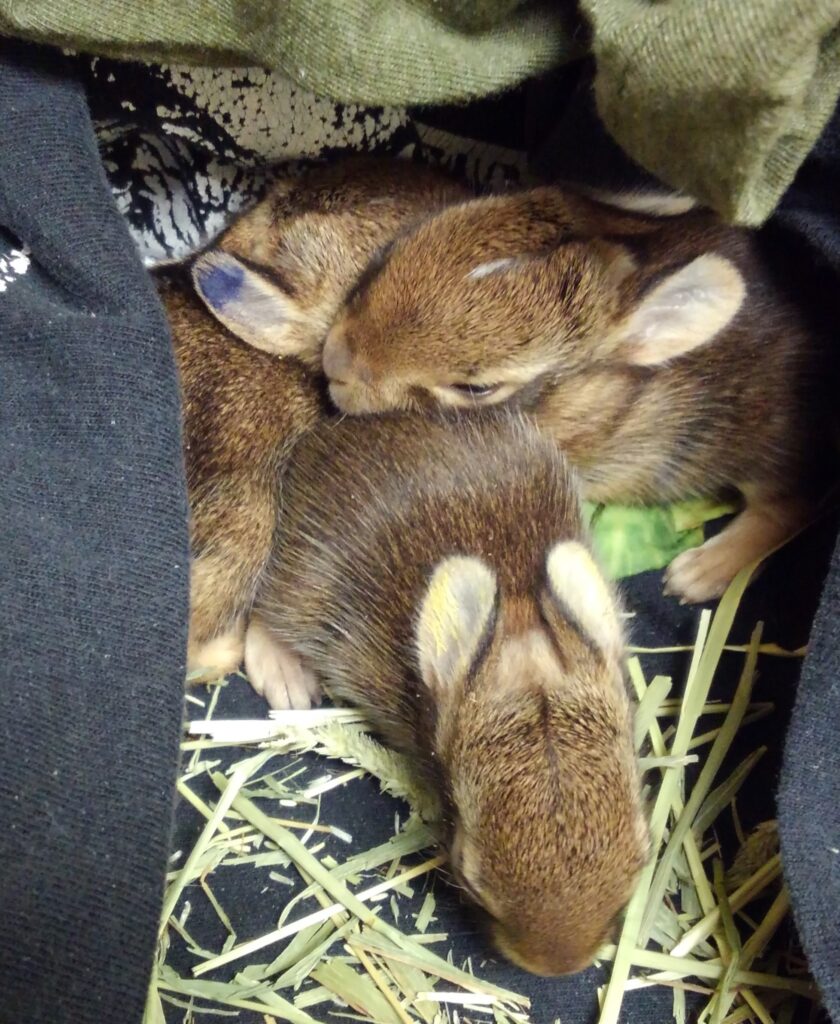
The best place for baby rabbits is with their mother, and every effort must be made to keep the family together. Please be careful not to kidnap babies from their mothers!
All alone in their nest?
Mother rabbits only return to feed their offspring at dawn and at dusk. It is normal for the nest to be unattended all day long. You may never see the mother because she is so careful not to lead predators to her babies. People and pets should be kept away from the area, especially around dawn and dusk so the mother will not be frightened to return.
Hopping around all by itself?
A healthy looking baby rabbit with its eyes open and ears up, around 4-5 inches long is able to survive on its own and is not in need of any help. Baby rabbits mature at 4-5 weeks of age while they are still quite small. It should not be disturbed.
Whose nest has been destroyed?
The nest can be repaired or reconstructed. In the original nest location, rearrange the original nest material and/or dry grass from the area so that there is a slight depression in the middle of it. Place the babies in the depression and cover them lightly with some more grass to conceal them from potential predators. Leave the area, and the mother will return at dusk to feed them.
In the middle of my lawn, and I’m afraid my dog/cat might harm them.
Do not try and move the nest or remove the rabbits. The rabbits best chance for survival is in the wild due to their extremely sensitive nature. If your pet can not be kept inside for a couple weeks, there are other things you can do to keep the rabbits safe and your pets happy. For example, placing a weighted-down laundry basket upside down over the rabbit’s nest during the day may be sufficient to protect the baby rabbits from small outdoor pets. To keep larger dogs out of trouble, a barrier of chicken wire should do the trick. Be sure to remove the laundry basket or chicken wire before dusk so that the mother can return, or leave an opening large enough for her to enter.
A baby rabbit should be taken to a wildlife rehabilitator for immediate assistance if…
- It has been attacked by a dog or cat
- Its mother is known to be dead
- It has been injured, e.g. by a lawnmower
- It is covered in insects
- It is laying on a sidewalk/open area all alone with no nest nearby
If the baby rabbit is in need of care from a wildlife rehabilitator, do not forget to keep it in a warm, dark, quiet box until further instructions are given.
Baby Squirrel
What do I do if I have found a Baby Squirrel/Squirrels…
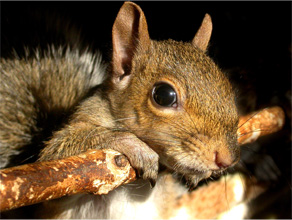
Photo courtesy of Jessica Weinberg
That has fallen from its nest?
Unless the baby squirrel is obviously injured, every attempt should be made to reunite the squirrel with its mother. It is all right to pick up and examine the baby to make sure it is ok. Human scents will not prevent a mother squirrel from taking back her offspring.
If the baby is cold, but appears otherwise healthy, the baby should be warmed up before an attempt is made to reunite it with its mother. This can be accomplished by placing the baby in a box with a t-shirt over a heating pad or other improvised heating device such as a sandwich bag or water bottle filled with hot water and inserted into a sock.
Once warm, the baby squirrel should be taken out to the tree from which it fell and placed in an improvised nest such as the box and t-shirt used or a hanging planter that the baby cannot climb or fall out of. Include some natural nest materials from the area (i.e. leaves or dry grass). Ideally, the nest should be mounted to a branch 8-10 feet up the tree. If the area is definitely safe from pets and other possible predators, and a branch cannot be found or reached, the nest can also be placed at the base of the tree from which the baby fell.
Leave the immediate area, and mom should hear her baby crying and come to get it. Mother squirrels can carry their babies in their mouth back to the original nest. Check on the nest box/basket after around 3 hours. If the mother has still not returned for her baby, contact your nearest wildlife rehabilitator.
In a tree that was just cut down?
Check to see if the baby squirrels are ok. If so, follow the procedures for a squirrel that has fallen from its nest, except place the temporary nest in or at the base of a neighboring tree. The mother squirrel often has a backup nest somewhere nearby and will come to retrieve her offspring once she hears them crying for her. If the babies have been injured or the mother squirrel has been killed, contact your nearest wildlife rehabilitator.
In my house or attic?
It is best to wait until the baby squirrels are 10 to 12 weeks old when they will leave the nest on their own in search of their own territory. In the meantime, pay close attention to how the squirrels get in and out. The best and most permanent way to keep squirrels out of your house is to prevent them from ever getting back in.
Once the baby squirrels are gone, you should begin repairing the holes through which they entered. During the early morning or just before dusk are good times to implement repairs since those are the times of da
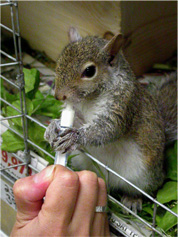
y when squirrels are foraging away from their nests. Be sure all of the squirrels are gone by sprinkling the floor near their old entrance with flour and checking for footprints.
Please do not trap and relocate wildlife. Contrary to popular belief, this is an inhumane practice that most often results in the relocated animal’s death, and during the spring and summer, may leave orphans behind.
Photo courtesy of Jessica Weinberg
A baby squirrel should be taken to a wildlife rehabilitator for immediate assistance if…
- It has been attacked by a dog or cat
- Its mother is known to be dead
- It has been injured
- It is covered with maggots, fleas or fly eggs
If the baby squirrel is in need of care from a wildlife rehabilitator, do not forget to keep it in a warm, dark, quiet box until further instructions are given.
Other Baby Mammal
What do I do if I have found a Baby…
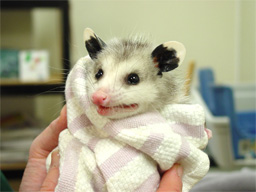
Opossum?
If the baby is six inches long or more from nose to rump, then it is actually old enough to be on its own and should be left alone. Just keep pets indoors until the opossum moves on. However, if the baby is smaller than six inches and there is no mother in sight, or the mother has been killed, then the baby opossum should be taken to your nearest wildlife rehabilitator. In the meantime, put the opossum in a dark, quiet box lined with a t-shirt and place the box half over a heating pad. Do not try to feed it anything.
Dead mother opossums may still have babies in their pouches. Please do not attempt to remove baby opossums from a deceased mother’s pouch, as they may still be physically attached to her. Place the mother and her babies in a box together and bring them all to the Wildlife Clinic.
Raccoon, Skunk, Groundhog, Bat or Fox?
Cute and little as they may be, these babies are all potential carriers of rabies. DO NOT touch or pick them up with your bare hands under ANY circumstances. If the baby animal is alone or appears to be orphaned, appearances may be deceiving. The baby may actually be well taken care of. Keep pets and people indoors and observe the baby animal. If the mother does not return after 3 hours or by dusk, contact your nearest wildlife rehabilitator. If it is necessary to handle a baby raccoon, skunk, groundhog, bat or fox, avoid any direct contact with the animal by using gloves and a large towel.
The Wildlife Clinic at the Schuylkill Center is not able to admit any Rabies Vector species (raccoons, skunks, groundhogs, bats, foxes, coyotes). Please do not bring these animals to the Clinic. You can call or email us for information on another nearby clinic that can help.
Deer?
Mother deer leave their fawns alone for most of the day, returning only a few times to feed them. Baby deer instinctively lay very still and quiet wherever mom has placed them. You may find fawns under your car, in an open garage, laying beside your house, etc. Their location may seem unusual to us, but mom found it appealing and decided this is where her baby should stay. If the baby is laying or standing quietly, it should be left completely alone. Keep kids and pets out of the area until the fawn has left. Never attempt to offer food or water to injured or orphaned wildlife.
If the fawn is wandering around and crying continuously for MORE than three hours, please call the Wildlife Clinic for assistance. Please do not attempt to catch or handle the fawn without instruction. Inappropriate contact can be fatal to deer.
A baby mammal should be taken to a wildlife rehabilitator for immediate assistance if…
- It has been attacked by a dog or cat
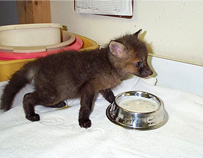
- Its mother is known to be dead
- It has been injured
- It is covered with maggots, fleas or fly eggs
If the baby mammal is in need of care from a wildlife rehabilitator, donot forget to keep it in a warm, dark, quiet place until further instructions are given.
- It has been attacked by a dog or cat
Reptile or Amphibian
What do I do if I have found a Reptile or Amphibian…
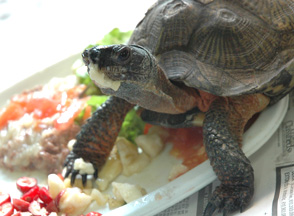
Photo courtesy of Jessica Weinberg
Crossing the street?
Turtles, in particular, can often be found in the middle of the road where they are in great danger of becoming roadkill. If you spot a small turtle or other non-threatening reptile or amphibian in the road, you can help by picking it up and taking it to the side of the road toward which the animal was already heading. Do not attempt to help the animal if it puts you in direct danger of traffic, etc. Bringing the animal back to the side of the road from which it came will only cause it to risk crossing the road again. Hold the animal away from you, as it probably won’t recognize your actions as helping and may try to pee on you or bite in self-defense.
Snapping turtles can be larger and far more dangerous to handle than other turtle species. If you find a snapping turtle in the road, you can help it along to the other side by dragging it backwards from the base of its tail onto a snow shovel, large piece of cardboard, or a large car floor mat so it can then be dragged safely across the street. Stay as far away from their head as possible, and do not attempt to lift them by their shell since snapping turtles can reach their heads around and inflict very powerful bites.
Do not relocate any wild reptile more than a few feet from where it was found. We may think we know a “good” habitat for these animals, but they know what they are doing and where they are going. Relocated reptiles often die trying to find their way home and may spread disease along the way.
In my house?
Snakes are the most likely reptiles to find their way into your house. Pennsylvania has only three venomous species, two types of rattlesnakes and a copperhead, all of which can be distinguished by elliptical pupils similar to those of a cat and a head pit between their eyes and snout. If the snake is venomous, it is best to leave it alone, close off the area, and contact your local animal control officer. Chances are, however, if you are a resident of PA, the snake is non-venomous (look for round pupils and no head pits) and can be easily removed from your house by scooping it up in a mesh net, cloth bag or pillowcase, twisting the top shut, and taking it outside where you can then release it.
That is a baby/very small?
Reptiles are independent from the moment they hatch. Even if they are very small, they know how to take care of themselves and should be left alone, unless they are in imminent danger or are clearly injured.
A reptile or amphibian should be taken to a wildlife rehabilitator for immediate assistance if…
- It has been injured, e.g. from trying to cross the street
If the reptile or amphibian is in need of care from a wildlife rehabilitator, do not forget to keep it in a warm, dark, quiet place until further instructions are given.
